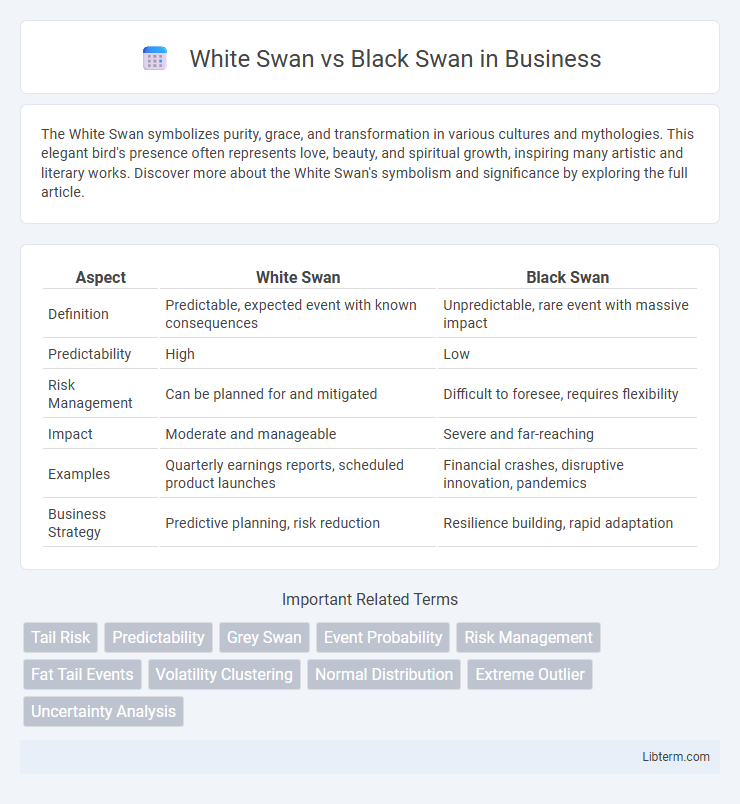The White Swan symbolizes purity, grace, and transformation in various cultures and mythologies. This elegant bird's presence often represents love, beauty, and spiritual growth, inspiring many artistic and literary works. Discover more about the White Swan's symbolism and significance by exploring the full article.
Table of Comparison
| Aspect | White Swan | Black Swan |
|---|---|---|
| Definition | Predictable, expected event with known consequences | Unpredictable, rare event with massive impact |
| Predictability | High | Low |
| Risk Management | Can be planned for and mitigated | Difficult to foresee, requires flexibility |
| Impact | Moderate and manageable | Severe and far-reaching |
| Examples | Quarterly earnings reports, scheduled product launches | Financial crashes, disruptive innovation, pandemics |
| Business Strategy | Predictive planning, risk reduction | Resilience building, rapid adaptation |
Introduction to White Swan and Black Swan
White Swan events are predictable, common occurrences with known probabilities and manageable impacts, often used in risk assessment and strategic planning. Black Swan events are rare, unpredictable, and have severe consequences, challenging conventional forecasting and requiring adaptive risk management. Understanding the contrast between White Swan and Black Swan enhances decision-making under uncertainty by differentiating between expected risks and extreme, unforeseen disruptions.
Defining White Swan Events
White Swan events are predictable occurrences with clear causes and measurable probabilities, in contrast to Black Swan events which are rare, unpredictable, and carry significant impact. These events typically align with established patterns and historical data, allowing analysts to forecast their likelihood accurately through risk assessment models. Understanding White Swan events is crucial for strategic planning, as they enable organizations to prepare for foreseeable outcomes and mitigate potential risks.
Understanding Black Swan Events
Black Swan events are rare, unpredictable occurrences with extreme impact that challenge standard forecasting models. These events, unlike White Swans which are expected and predictable, reveal the limitations of traditional risk assessment and emphasize the importance of robustness and adaptability in complex systems. Understanding Black Swans involves recognizing the inherent uncertainty in markets and societies, promoting resilience rather than reliance on precise prediction.
Key Differences Between White Swan and Black Swan
White Swan events are predictable, based on historical data and observable trends, whereas Black Swan events are rare, unpredictable, and have extreme impact. White Swans are characterized by their high probability and known consequences, while Black Swans are unforeseen, with consequences that often reshape industries or societies. The key difference lies in predictability and impact severity, with Black Swans defying conventional risk management models.
Historical Examples of White Swan Events
White Swan events are predictable and expected occurrences supported by historical data, such as the 2008 Global Financial Crisis triggered by the collapse of major financial institutions like Lehman Brothers. The 1918 Spanish Flu pandemic is another example, as public health experts had anticipated such large-scale epidemics based on previous flu outbreaks. Industrial revolutions, including the first in the late 18th century, exemplify White Swan events due to their gradual development and long-term impact on economic and social structures.
Notable Instances of Black Swan Events
Notable instances of Black Swan events include the 2008 global financial crisis, which triggered widespread economic turmoil and market collapse due to unforeseen financial system vulnerabilities. The September 11, 2001 terrorist attacks reshaped global security policies and had profound geopolitical impacts far beyond initial expectations. The COVID-19 pandemic disrupted global health systems and economies worldwide, highlighting vulnerabilities in public health preparedness and supply chain resilience.
Predictability: White Swan vs Black Swan
White Swan events are highly predictable and fall within the realm of expected occurrences based on historical data and known risks. Black Swan events are unpredictable, rare, and have extreme impact, defying conventional forecasting models and assumptions. The fundamental difference in predictability lies in White Swan's reliance on statistical probability while Black Swan represents unforeseen anomalies that disrupt normal expectations.
Impact and Consequences of Each Event Type
White Swan events are predictable occurrences with known probabilities, allowing organizations to prepare effective risk management strategies that minimize disruption and financial loss. Black Swan events are rare, unforeseen, and have extreme impact, often causing systemic failures, market crashes, or widespread societal upheaval due to their unpredictable nature and the inability to adequately prepare. The consequences of Black Swan events often include long-term structural changes in markets and policies, while White Swan events result in more localized and manageable outcomes.
Managing White Swan and Black Swan Risks
Managing White Swan risks involves identifying predictable events through rigorous risk assessment frameworks and implementing standardized controls such as compliance measures and contingency planning. Black Swan risks require adaptive strategies emphasizing agile response systems, scenario analysis, and fostering organizational resilience to navigate unforeseen, high-impact disruptions. Effective risk management integrates both approaches by combining data-driven forecasting with flexible, crisis-ready protocols to safeguard against known and unknown threats.
Conclusion: Lessons from Swans in Risk Analysis
White Swan events represent predictable risks with known probabilities, whereas Black Swan events are rare, unpredictable, and have massive impact. Effective risk analysis should incorporate both by preparing for expected challenges while maintaining agility to respond to unforeseen crises. Emphasizing resilience and flexible strategies helps organizations mitigate damage from Black Swans while optimizing responses to White Swan scenarios.
White Swan Infographic

 libterm.com
libterm.com